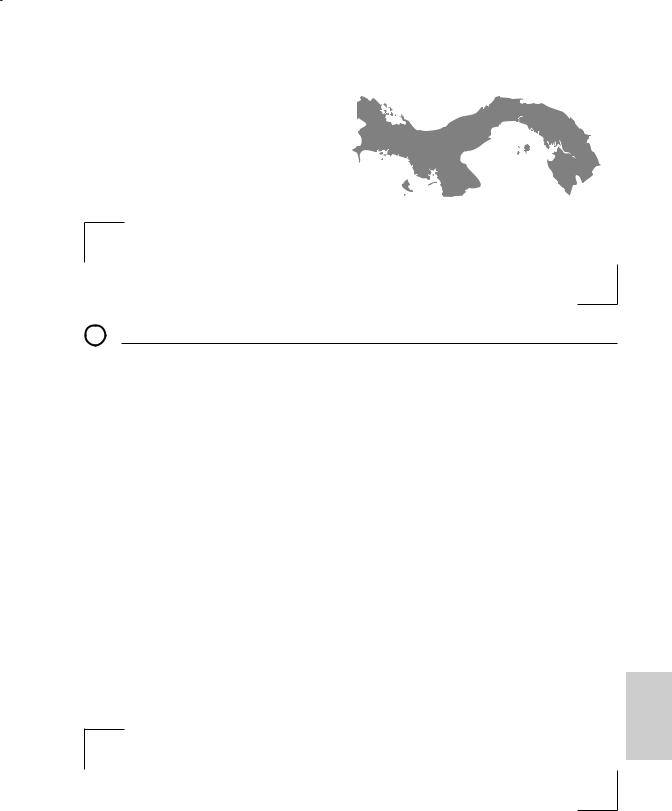
- •Contents
- •Preface
- •Introduction
- •Cultural Orientation
- •Argentina
- •Austria
- •Australia
- •Belarus
- •Belgium
- •Belize
- •Bolivia
- •Brazil
- •Canada
- •Chile
- •China
- •Hong Kong
- •Colombia
- •Costa Rica
- •Czech Republic
- •Denmark
- •Ecuador
- •Egypt
- •Finland
- •France
- •Germany
- •Greece
- •Guatemala
- •Honduras
- •Hungary
- •India
- •Indonesia
- •Ireland
- •Israel
- •Italy
- •Japan
- •Kuwait
- •Malaysia
- •Mexico
- •The Netherlands
- •New Zealand
- •Norway
- •Pakistan
- •Panama
- •Paraguay
- •Peru
- •Philippines
- •Poland
- •Portugal
- •Romania
- •Russia
- •Saudi Arabia
- •Singapore
- •South Africa
- •South Korea
- •Spain
- •Sweden
- •Switzerland
- •Taiwan
- •Thailand
- •Turkey
- •Ukraine
- •United Kingdom
- •United States
- •Uruguay
- •Venezuela
- •Vietnam
- •Index

Panama
Republic of Panama
Local short form: Panama
Local long form: Republica de Panama
Cultural Note
Panamanians are sensitive about the influence of the United States on their country. Be careful not to remark how “Americanized” the people are, nor should you refer to U.S. citizens as “Americans,” since everyone from North, Central, and South America is an American.
●3 What is your Cultural IQ?
1.Panamanians enjoy many sports. In which one have they produced fourteen world champions?
a. |
Soccer |
c. |
Cockfighting |
b. |
Baseball |
d. |
Boxing |
ANSWER: d. Many Panamanians are avidly interested in boxing. Their fourteen world boxing champions include Roberto Duran.
2. True or False? In 1501, Spanish navigator Rodrigo de Bastidas led the first European expedition to reach Panama.
ANSWER: True. Rodrigo de Bastidas beat Christopher Columbus to Panama; Columbus arrived later, on his fourth and final voyage to the New World.
3. True or False: Alone among Spain’s former colonies, Panama remained prosperous after
Spain gave up its claims to Latin America. |
|
ANSWER: False. Panama’s importance declined when Spain lost her colonies in South and |
|
Central America. Revenues sagged. It took the 1848 discovery of gold in California to |
|
revive Panama’s fortunes. As a result, thousands of U.S. citizens from the East Coast trav- |
|
eled to California via Panama (rather than making the long, dangerous land journey |
|
across the United States). |
Panama |
|
Cultural Note
Although its distribution of wealth is very unequal, Panama remains the wealthiest Central American nation, in large part due to the Panama Canal and investment from the United States. (Mexico is wealthier, but it is considered part of North America, not Central America.)
357

358 |
Kiss, Bow, or Shake Hands |
●3 Tips on Doing Business in Panama
●Panamanians prefer to maintain an image of harmony in public. People are criticized in private, out of hearing of others. Do not criticize or disagree with other members of your negotiating team in public.
●White, urban Panamanians hold most of the country’s wealth and power. They have the inelegant nickname los rabiblancos (whitetails). Many of them speak English as well as Spanish. They are a separate group from the rural landowners, who never achieved the political influence that is characteristic of agricultural barons elsewhere in Central America.
●Many Panamanians have nicknames. Even powerful politicians are often referred to by their nicknames. Dictator Manuel Antonio Noriega was known as la Piña (the Pineapple) due to his pockmarked complexion. His successor as president, the pleasant and rotund Guillermo Endara, was called Pan de Dulce (Honey Bun)!
Panama
●3 Country Background
History
Columbus reached Panama in 1502 on his fourth and final voyage to the New World. In 1513 Vasco Núñez de Balboa crossed the width of the isthmus and proved it could provide a path for transport of goods between the Pacific and Atlantic. Subsequently, Panama became a transshipment point; Spain brought its silver and gold up to Panama via ship, then portaged overland via the Camino Real (Royal Road) and loaded it back onto ships bound for Spain. An alternate name for the cross-country trail was the Camino de Cruces (Road of the Crosses)—based on all the graves.
The Spanish included Panama as part of the viceroyalty of New Grenada. Most of Central America declared its independence from Spain in 1821. Rather than going it alone, Panama joined the already-independent nation of Colombia. This union (known as “Gran Colombia”) was not entirely successful, and many Panamanians sought independence from Colombia.
The first major U.S. investment in Panama was in 1855, when a railroad was built to ferry people and goods between the coasts. This was prompted by the California gold rush of 1849. Thousands of miners traveled from the Atlantic coast of the United States by sea to Panama, traversed Panama, then took a ship from Panama’s Pacific coast to California.
Gran Colombia was reorganized in 1886 as the Republic of Colombia. The autonomy that Panamanians enjoyed was lost in the reorganization. The Panamanian independence movement dates its origin to this time.
The French tried and failed to build a canal across Panama in the 1880s.

Panama |
359 |
In the wake of the 1898 Spanish-American War, the United States of America became determined to build a canal. The Panama isthmus was the favored site, but Colombia refused to grant the required concessions.
The USA supported Panamanian independence, in return for concessions (primarily the establishment of the U.S.-controlled Panama Canal Zone). The canal was finally completed in 1914, and changed the nature of world trade. It returned to Panamanian control on December 31, 1999. In the same year, Panamanians elected their first female president, Mireya Elisa Moscoso Rodríguez. For better or worse, the Panamanian agency charged with running the canal, the Panama Canal Authority, is largely autonomous—beyond the control of elected Panamanian politicians.
Since its independence from Colombia in 1903, Panama has been a republic. The military often dominated the government until 1989, when dictator General Manuel Noriega was overthrown by U.S. forces and civil rule was instituted.
Type of Government
Panama is a multiparty republic, with a president, two vice presidents, a Cabinet, a unicameral Legislative Assembly serving five-year terms, and a Supreme Court. The president is the head of state and the head of the government.
Frequently dominated by its military, the Republic of Panama has had a peaceful transfer of power between civilian governments since General Manuel Noriega was removed in 1989. (However, even during the Noriega era, the appearance of elective government was maintained.)
For current government data, check with the Embassy of Panama in your country.
Language
Spanish is the official language of Panama. Many Panamanians are bilingual in English as well. There are several Amerindian languages. Ethnologue.com has identified fourteen distinct languages in current use in Panama. (Two of these are languages of Chinese immigrants.)
The Panamanian View
Traditionally a Roman Catholic country, Protestantism has made significant gains in the recent past. Around 80 percent of Panamanians identify themselves as Roman Catholics. Protestants now make up about 15 percent, more than half of them belonging to Pentecostal groups. There are also small numbers of Muslims, Hindus, and others.
Panama has no official religion.
The family remains the single most powerful social unit. Nepotism is considered proper at all levels of society.
Attitudes toward the United States—known as El Gigante del Norte (the Giant to the North)—are complex. Some Panamanians blame the United State’s long domination of Panama for all their country’s problems. Nevertheless, many Panamanians view the United
Panama

360 |
Kiss, Bow, or Shake Hands |
States as their best opportunity for education and advancement; thousands of Panamanians live in the United States.
*Know Before You Go
■
Aside from street crime, the greatest hazard to visitors comes from the heat and humidity. Panamanian drivers also represent a danger. Many drivers ignore traffic signs in Panama.
If you go swimming in either the Atlantic or Pacific Ocean, there are dangerous riptides off many Panamanian beaches.
Despite the current government’s best efforts, Panama is still listed as a major cocaine transshipment point and primary money-laundering center for narcotics revenue; money-laundering activity is especially heavy in the Colon Free Zone; official corruption remains a major problem.
Panama
●3 Cultural Orientation
Cognitive Styles: How Panamanians Organize and Process Information
Perhaps because Panama has long been a transit port for goods and people from many nations, Panamanians are open to information of many kinds. Panamanians are also very politicized, which shades how they view this information. For example, members of antiAmerican or antiglobalization parties may resist any data from the United States. Panamanians typically process information subjectively and associatively. Their personal involvement in a problem may make it unlikely that they will apply rules or laws to solve it.
Negotiation Strategies: What Panamanians Accept as Evidence
Truth is found in the immediate feelings of the person involved. However, this truth may be influenced by a strong faith in the ideologies of nationalism. Unless they have been educated abroad, older Panamanians will seldom let objective facts stand in the way of their desires. Younger Panamanians may view matters less subjectively.
Value Systems: The Basis for Behavior
The following three sections identify the Value Systems in the predominant culture—their methods of dividing right from wrong, good from evil, and so forth.
Locus of Decision-Making
The individual makes the decisions, but always in light of their effect on the family or group to which he or she belongs. It is difficult for Panamanians to make a negative decision. Personal relationships are everything, and Panamanians strive to maintain them at all costs. A small, elite oligarchy is now in power, and they have historically made decisions favorable to the interests of the United States.

Panama |
361 |
Sources of Anxiety Reduction
The extended family is the surest defense against a hostile and uncertain world. There is a strong work ethic, but levels of production are not highly evident. This is a laid-back society that does not let time dictate its behavior. Panamanians are followers of strong leaders. The rituals and precepts of the Catholic Church give structure to societal behavior.
Panamanians have been charted as having a relatively low individualism index. This indicates a collectivist society in which groups look out for the welfare of each individual member.
Issues of Equality/Inequality
There is a large gap between rich and poor, a fairly large middle class, and a large lower class. Panama has been listed as being tied with Guatemala for the highest power distance in Latin America. This indicates a great difference between the wealthy and the poor, as well as widespread acceptance of this situation. However, younger Panamanians no longer believe that the powerful elite are entitled to unlimited privileges. There is an inherent trust in people, so one needs to cultivate friendships. Machismo is strong. Most Panamanian men believe that the ideal focus for a woman is a home, family, and children.
●3 Business Practices
Punctuality, Appointments, and Local Time
●Punctuality, although not strictly adhered to in daily living, is expected in business circles—particularly with foreigners.
●If you are invited to a party, never be on time. For dinner parties, it is appropriate to arrive up to one hour late if there are several guests, and up to thirty minutes late if you are alone. At large parties, you may arrive up to two hours late.
●Remember that many Europeans and South Americans write the day first, then the month, then the year (e.g., December 3, 2010, is written 3.12.10 or 3/12/10). Although Panamanians are familiar with the day-month-year format of the USA, they will generally write it in the conventional form for South America.
●Make appointments as far in advance of your arrival in Panama as possible. Confirm your arrival via phone or e-mail at least one week ahead of time.
●Local time is five hours behind Greenwich Mean Time (G.M.T. –5).
Negotiating
●Contract negotiations proceed at a much slower pace than in northern Europe or North America. Be patient with delays, and be prepared to travel to Panama more than once to finalize a transaction.
●Business is conducted among friends in Panama. Therefore, spend time establishing a relationship with your counterpart before jumping into business discussions. Emphasize
Panama

362 |
Kiss, Bow, or Shake Hands |
Panama
the personal compatibility of the two companies and develop a high level of trust, rather than focusing solely on the logical bottom line.
●Although more women are moving into higher managerial positions, they are still relatively rare. Women should emphasize the fact that they are part of a team from a company that is strongly committed to doing business in Panama.
●Have business cards and other material printed in Spanish as well as English.
●Adjust your starting price to allow a margin for bargaining.
●Latin Americans tend to be status conscious. At least one member of the negotiating team should be from a high level of management.
●Panamanians believe in the intrinsic worth of the individual and treat one another with respect and dignity, regardless of a person’s social standing or material wealth. Therefore, it is very important not to publicly criticize a person.
●To avoid embarrassment, Panamanians rarely disagree with anyone in public. This can extend to a foreign businessperson trying to close a deal; a Panamanian may tell a foreigner “yes” simply to be polite. Lukewarm affirmatives, like “maybe” or “we will see,” are polite ways of saying “no.” A “yes” is not final until a contract is signed.
●A familiarity with Panamanian history, sites, culture, and art will impress your counterparts.
●Senior officials and the elderly are given preferential treatment. They should be greeted first and may be served before you in a line.
Business Entertaining
●Always stay at the best hotels and entertain your guests at premier restaurants. Ask your client’s secretary about any preferences the client may have for restaurants or clubs.
●Good topics of conversation include sports, travel, and local cultural events. Avoid supporting claims that “the Canal was run better by the United States,” even if they are made by a Panamanian.
●Foreign businesswomen should always include spouses in invitations to business dinners.
●To pay for either a lunch or dinner with male clients, women should arrange to take care of the bill privately with the waiter. If the check is brought to the table, the men will strongly resist letting a woman pay. Give the waiter your credit card beforehand or, if you are hosting a dinner at your hotel, arrange to have the charge added to your hotel bill.
Cultural Note
Citizens of the United States working in Panama have often remained separate from Panamanians in business and social networks. To encourage better cultural and business ties, businesses should plan and support fully integrated functions.

Panama |
363 |
●3 Protocol
Greetings
●Men usually shake hands in greeting. Women will often pat each other on the right forearm or shoulder instead of shaking hands. If they are friends, they may hug or kiss each other on the cheek.
●At parties, it is customary to greet and shake hands with each person in the room.
Titles/Forms of Address
●Titles are very important in Panama and should be used whenever possible. When addressing someone directly, use the title alone and do not include a last name (Profesor, Doctor, and so forth). The title Licenciado is used for anyone with a bachelor’s degree.
●Traditionally, first names were used only by persons on a familiar basis; however, younger executives may move to the use of first names with business associates from North America.
●For further information on the proper titles and forms of address for Spanish-speaking countries, please consult Appendix A.
Gestures
●Because of the long-standing presence of the United States in Panama, most North American gestures (and insults) are understood.
Gifts
●Gifts are not required in a business setting. However, after the first few meetings, you may want to bring a gift from your home state, such as a local craft or illustrated book. Other good gifts include the latest electronic gadgets or expensive liquor.
●Gifts are appropriate if you are invited to a Panamanian home or if you are visiting rural areas. Some good options are chocolates, wine, Scotch, or local crafts from home.
●Gifts are not expected, however, and it is enough to extend your thanks and to invite your hosts to a meal in return.
Dress
● |
In theory, men should wear a conservative business suit for work. |
|
● |
In practice, jackets and ties are often dispensed with in Panama’s hot, humid weather. |
Panama |
|
Panamanian businessmen in higher positions wear suits; others wear camisillas (a light- |
|
|
weight, open-necked shirt that is not tucked inside the trousers). |
|
● |
Women should wear a skirt and blouse or a dress. |
|
● |
Pants, including jeans, and a shirt are appropriate casualwear in the city. Shorts are not |
|
|
often worn by either sex, and women should avoid any revealing clothing. A woman |
|
|
wearing pants in a rural area may draw some attention. |
|
